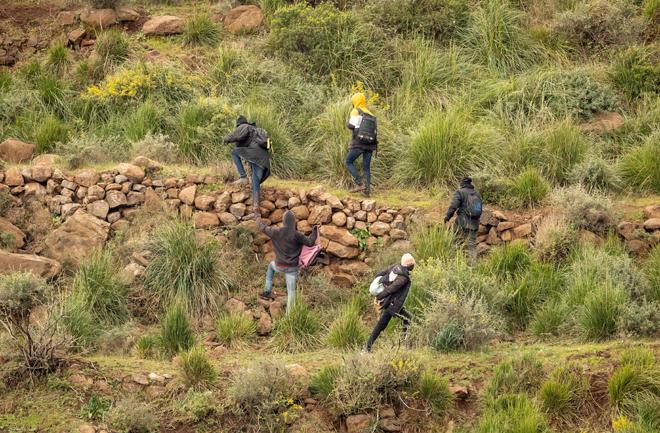You are here
Living rough in Morocco, migrants dream of Spanish enclave
By AFP - Mar 05,2022 - Last updated at Mar 05,2022

Migrants climb a ledge along a mountain path after an attempted assault on the border fence separating Morocco from Spain's North African Melilla, near Nador, on Friday (AFP photo)
NADOR, Morocco — When 2,500 migrants stormed Morocco's border with a Spanish enclave this week, Mahjoub Abdellah wasn't among the hundreds who made it across — but he is determined to try again.
The 22-year-old from the war-devastated region of Darfur in western Sudan was nursing a foot injury on Friday at a makeshift camp in a Moroccan forest near Melilla, a tiny Spanish territory which he sees as his route to "a dignified life".
"If I get a chance, I'll try again," he said.
Spanish authorities say Wednesday's incident was the biggest such crossing attempt on record, with almost 500 managing to cross into European Union territory.
Melilla and Ceuta, Spain's other tiny North African enclave, have the European Union's only land borders with Africa.
That makes them a magnet for migrants desperate to escape poverty, violence and hunger both at home and during their journeys across Africa.
"I'm tired. I spent three months living in this forest, under the rain," Abdellah said.
"Even animals couldn't live in these conditions."
He plans to leave the drab town of Nador, near Melilla, to try to earn some money elsewhere — and prepare another attempt.
Cat and mouse
Melilla, a welcoming city for sunseeking European tourists, sits a stone's throw across the border from the Gourougou Massif, a forested mountain that has long served as a grim hideout for migrants hoping to reach European territory.
To do so, they have to brave successive layers of razor wire, ditches and high fences — and an at times violent game of cat-and-mouse with both Moroccan and Spanish security forces.
Spain says over 800 migrants managed to cross Melilla's heavily fortified 12 kilometre frontier this week, compared to 1,092 in the whole of last year.
They said the migrants had thrown rocks and used "violence" against security forces.
Moroccan Association for Human Rights (AMDH) said some 30 migrants were injured in Wednesday's rush, three or four of them seriously.
On Friday, Moroccan police were deployed along the fence near the town of Beni Ansar as migrants walked in freezing gusts of wind along the rugged paths of Gourougou.
'No hope back home'
Ahmed Mohamed, another migrant from Sudan, also tried to reach Melilla on Wednesday.
He is just 17 years old, but has lost count of how many times he has attempted the crossing since he arrived in Morocco eight months ago.
After his failed attempts, he is sent back each time to the Casablanca or Safi regions, hundreds of kilometres away.
"One day, I'm going to achieve my dream," he told AFP. "Back home, there's no hope any more."
Like many of his companions, he said he entered Morocco via neighbouring Algeria, but he prefers not to reveal the exact route.
Another 17-year-old, a Chadian girl with a tattooed forehead, begged to be let into Europe.
"Open the borders, help us! We're sick of being chased and harassed," she said.
She had not tried to cross this week but would stop at nothing to succeed.
In mid-May 2021, Spain was caught off guard when more than 10,000 people swam or used small inflatable boats to enter Ceuta as Moroccan border forces looked the other way.
The incident, at the height of a diplomatic spat between Rabat and Madrid, showed how heavily Spain relies on Moroccan cooperation to rein in clandestine migration.
Related Articles
RABAT — Moroccan police have arrested 25 more African migrants near the border with a Spanish enclave where at least 23 people died in a Jun
RABAT — A Moroccan appeals court has increased the prison sentences of eight migrants over a deadly attempted crossing into the Spanish encl
NADOR, Morocco — A Moroccan court on Tuesday sentenced 33 migrants to 11 months in jail for “illegal entry”, their lawyer said, after a dead











